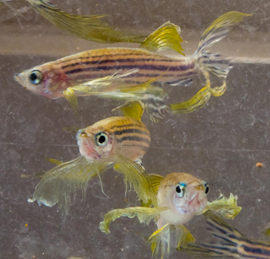
At first glance, it’s hard to see many similarities among people, mice, and zebrafish. But much of what we know about the earliest stages of human development and birth defects* come from studying the development of these animals.
How can research on “animal models” apply to people?
“The simple answer is because of evolution,” said Lorette C. Javois, Ph.D., from NICHD’s Developmental Biology and Structural Variation Branch.
Humans and animals share common ancestors from millions of years ago. Over time, as animals and humans took different evolutionary paths, their DNA maintained similarities. The closer two animals are on the evolutionary path, the more similar their genomes. For example, the human and mouse genomes are about 90% the same, while we have only about 70% of the same genetic material of a zebrafish.
Why use animal models in research on human development?
Animal models provide something that other research methods cannot. “Even the most sophisticated technology cannot mimic the complicated interactions that occur among cells, tissues, and organs in humans and animals,” Dr. Javois said. “Learning more about these interactions helps us understand the basic processes of life. It also allows us to better understand what happens when things go wrong, and that knowledge lays the foundation for advances in disease diagnosis, treatment, and prevention.”
Animal models also are easier to use in research than humans. Animals generally reproduce in greater numbers and have shorter lifespans, so researchers can study more animals—and multiple generations—in a shorter period of time.
How do researchers choose which animal model they want to use?
Researchers choose model organisms in large part based on how easily they can be used in the laboratory. Among the factors researchers consider are:
- How much it costs to maintain the animals
- How quickly they reproduce
- How quickly they cycle through their lifespan
These are a few of the most common animal models:

Worm and fly
- Easy to obtain and grow
- Reproduce in great numbers
- Mature and die quickly
- Require little laboratory space

Zebrafish
- Reproduce and mature quickly
- Have transparent eggs and embryos, which allows researchers to watch development occur in real time

Mouse
- Enable researchers to easily add or delete genes to study their function (referred to as knocking in or knocking out the genes)
What have we learned about human development and birth defects from animal models?
Animal models have taught us a great deal about human development and birth defects. For example:
- Researchers have used zebrafish, mouse, and fly models to investigate Cornelia de Lange Syndrome, a condition characterized by slow growth before and after birth, intellectual disability, and skeletal abnormalities. After an early genetic discovery with the fly model, researchers identified Nipbl gene mutations in more than half of people with this condition. A recent zebrafish study showed that Nipbl plays a role in regulating many gene interactions. When the gene is defective, these gene interactions are thrown off, leading to the spectrum of congenital defects seen in the syndrome.
- Researchers working with mice have uncovered a potential clue to polydactyly, a birth defect involving extra fingers or toes. They found that a mouse version of polydactyly results from a malfunction of the cellular machinery that processes endosomes, balloon-like structures involved in transporting molecules within a cell.
- Using a mouse model, researchers have found that excessive transforming growth factor-β signaling—which fosters tissue formation and growth during embryonic development—is a key player in osteogenesis imperfecta (OI), a group of genetic disorders in which bones break easily. The study may help bring scientists one step closer to a treatment for OI.
- Studies with mice and zebrafish have found that a mutation in the gene CCDC40 causes defects in the placement of major organs, such as the heart and lungs, on the left or right side of the body. The studies provided evidence of a genetic link between the respiratory disorder primary ciliary dyskinesia and the heart problems seen in patients with this disorder.
In addition to conducting research with existing animal models, scientists also are developing new animal models. For example, researchers supported by the National Institute of Neurological Disorders and Stroke have developed a new method for studying neural tube closure in mouse embryos. This animal model could help researchers better understand how neural tube defects arise in people and identify new strategies for intervention.
Animal models will continue to play an important part in research on human development, as scientists work to find ways to prevent birth defects and treat them when they occur.
*We know that the term “birth defects” carries negative undertones and does not reflect the many abilities and talents of those affected by these conditions. Communities are discussing alternative terms but have not yet reached a consensus.
More Information
- NICHD Resources:
- Division of Extramural Research
- Developmental Biology and Structural Variation Branch
- Trans-NIH Structural Birth Defects Working Group
- Developmental Biology and Structural Variation Branch
- Related A to Z Topics:
- NICHD Efforts Related to Birth Defects:
- Previous NICHD Spotlights on Birth Defects:
- Understanding Typical & Atypical Development: Research at the Heart of the NICHD Mission
- Alcohol & Drug-Related Birth Defects Research at the NICHD
- Spina Bifida Surgery in the Womb Decreases Complications
- MOMS: Seeking Moms to Understand Best Treatment for Spina Bifida
- The NICHD & Newborn Screening: A New Era
- NICHD News Releases on Birth Defects
- Division of Extramural Research
- NIH Resources
- Office of Extramural Research: Animals in Research
Originally Posted: January 9, 2015

 BACK TO TOP
BACK TO TOP